
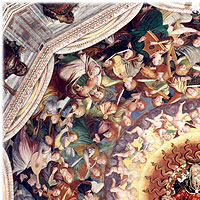
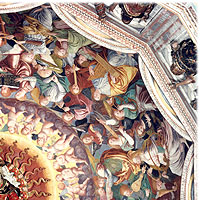
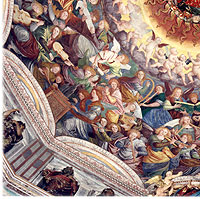
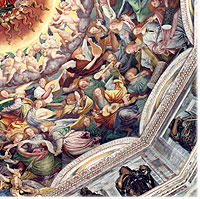
The pilgrims entering the Sanctuary of Saronno had to walk in semi-darkness their eyes timorous and unsure, until they reached the area under the dome, when, almost like an act of devotion, they would look up, heavenwards. And here was an explosion of colors, forms, figures, objects, a beating of wings and movement of air never seen before, this concert of angels rejoicing at the arrival of the Virgin Mary in Paradise (which meant that everyone would get there, once their sins were forgiven and they had passed through the darkness of death).
The Paradise painted by Gaudenzio Ferrari was certainly, for the devout, the Paradise of every wellborn soul. Perhaps also for the artist, reaching it after the labors of the Sacred Mounts of Varallo, the falls on the way to Calvary, the flagellations, the spitting, the crown of thorns and the cross, this was the moment, in this concert he was commissioned to paint, to rediscover Paradise, the paradise of the soul and the body, the moment when, following the latent aspiration that, leaving behind the rigors and restrictions of the CounterReformation, having defeated plague and pestilence, he could find once again the pleasure of music and Paradise.
The planetarium of music
So let’s close our eyes and immerse ourselves in the penumbra of the time. Music and Paradise a pair celebrated since antiquity, alive still today in the etymology of the word music, which, some scholars tell us, derives from the Muses, the mythological protectors of the arts, to whom the heights of Olympus, Helicon, and Parnassus were consecrated. According to others, its evocative origins spring from the Egypt of the Pharaohs, where Moses is said to have invented the organization of sounds we call music.
Whichever of these is true, the verticality of heaven and the thrust towards a higher world are implicit. The idea of transcendence over earthly things is a guaranteed component of art that strives to express a journey upwards. The voyage of Orpheus, who by mere sound is able to overcome the barriers of Hades and brings his bride Eurydice back to the land of the living, is an emblematic example. The art of sound overcomes the inferno and nature and wins a place in the heavenly spheres.
Literature is an inexhaustible mine of instances where this pair is celebrated, and it gives us repeated convergences between music and spiritual joys. Just one example is this quotation taken from a musical debate: “Listening to that concert which is universally celebrated by so many different musicians in Italy and abroad, one heard such a sweet and melodious harmony of horns, trombones, violins, viols, double harps, lutes, bagpipes, flutes, harpsichords, and voices all at the same time, that it really seemed like the mount of Parnassus and Paradise itself opened up, and not like something human”. This was said by one Giovanni Maria Artusi, who had a diatribe with Claudio Monteverdi over certain solutions too daring for his ear.
Well before Artusi, Dante, in the Divine Comedy, leaving the Inferno behind him, on the slopes of Purgatory that would lead him to the spheres of heaven encountered Casella’s loving song: “’Love that discourses in my mind,’ he then began so sweetly that the sweetness still within me sounds” (Purgatory, Canto ll, 112-114) And even before Dante, in the fifth century B.C., the Pythagorean school worked out a theory of the harmony of the spheres, later inherited by Boethius and Cassiodorus and transmitted through them to the medieval world and to Dante himselfin the classification of musica mundana, humana et instrumentis constituta. Anselmo of Parma, reworking the teachings of Platonic cosmology and the theories of Boethius, imagined a planetary range of three octaves, to which the variability or diversity of sounds emitted by the seven planetary spheres and the fixed stars corresponded. In short, to emerge from the impervious paths of medieval sciences based on faith in auctoritas, this was an immense polyphonic concert, far removed from the theoretical abstraction of the Pythagoreans.
And isn’t Gaudenzio’s Paradise, in which the instruments named by Artusi are placed in the cosmic atmosphere of Boethius and the harmonious and festive figurative art of the Renaissance, a veritable narration using abstract images?
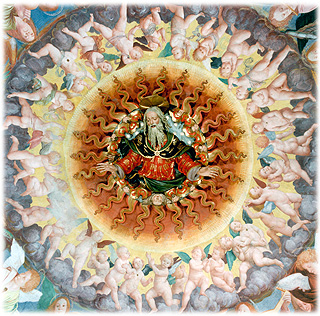
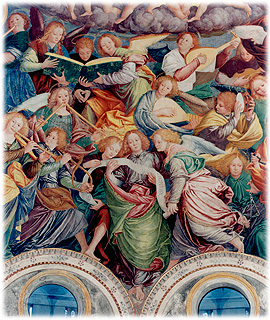
The dome and Paradise
The iconography of music is so rich in examples that it is impossible to examine it in its totality. Miniatures, Books of Hours, triptychs, canvases and altarpieces all confirm the significance of joy and heavenly bliss linked with music, which is the overarching theme of the fresco of The Concert of Angels in the dome of the Sanctuary of Saronno.
In church architecture, the dome has a transcendent meaning as well: to give visual expression to the universe and indicate a striving towards heaven, the place considered the kingdom of the blessed since the origins of mankind.
Of course, the sense of opening upwards is one of the most immediate meanings that religious architecture expresses in its millennial history, from the strong ascensional thrust of Gothic architecture based on tall pillars, oversailing coursés and large stained-glass windows open to the light outside, to the geometric balance of the Renaissance that reveals also through numbers the desire for the Absolute. For this same reason, domes often open pictorially onto visions of heaven inhabited by angel musicians. The Saronno dome does not elude this desire, but reunites in one visual conception the premises and acquisitions of the art of its time and earlier. It expresses the striving for the Summit through various “circles” (and here the reference is evident to the “pure white rose” in canto XXXI of Dante’s Paradise) that terminate in the figure of the Eternal Father surrounded by flames of fire. The largest circle is made up of a crowd of angel musicians moving about in a “concerted” ensemble of poses and gestures expressing a psychological range. Their emotional participation in the concert is manifest, even if the representation is less attentive to the correct use of the instrument than to the spirituality of the scene, evident mainly in their pale faces, drained by a burning inner ardor, and their hands that, whether holding a book or a scroll or dancing across the keyboard, are captured in a fleeting moment, as though crystallized in an eternity of indescribable grace and ineffable music.
I said a crowd, but a closer look reveals, in this great concert, small groups of musicians who, like in a real concert, are both a part and the whole, according to the demands of the musical score, and form a fabric that is at once united and divided, in which the harmony is suggested visually since it cannot be expressed acoustically. The second circle consists of a dance of thirty winged cherubs, which through the beautiful play of their limbs hands and legs that seem animated by an uncontainable joy, as well as by the typical energy of childhood connects to the Divine Mover sought by their eyes (just one looks off in another direction, signaling that the circle can continue forever). Certainly this ring is inspired and set in motion by the music beneath it, and serves as a link to the Eternal.
Human Music
While the location par excellence for angelic concerts is the dome, there is no lack of musical decorations in other parts of the church, such as the apses, arches, and vaults, always participating in the tension upwards that music expresses in and of itself. Some examples in the Saronno area, more or less from the same period, can be connected with the frescoes in the Sanctuary dome, not so much for stylistic or pictorial affinity as for the idea of making music and of making it to God’s glory without losing sight of the fact that the glory of God arose from the earthly pleasure of making music here and now, whether in an improvised concert in the open air or inside, in an aristocratic environment or of the people. An interesting instance of this is the conch of the apse of the basilica of San Simpliciano in Milan, frescoed by Bergognone in 1508 (according to the recent date given it by Mazzini), showing seventy-seven angel musicians surrounding the mandorla in which the Holy Trinity, acting through Christ, crowns the Virgin Mary Queen of Heaven. We should not miss the analogy of the Marian theme reinforced also by the presence of some of the instruments that we find on the dome in Saronno, even though they are depicted differently.
Interesting, too, are the two concerts painted by Gian Pietro Luini around midcentury on the ceiling of the last chapel on the left of the public church which is part of the complex of the Monastero Maggiore di San Maurizio in Milan. Even more prominently pictured there are musical aspects tied to the customs of the time: two instrumental groups made up of an ensemble of viols and one of mixed instruments (the terminology in use in England in the sixteenth and seventeenth centuries called these a whole consort to mean instruments from the same family and broken consortto underline the difference in timbre of the instruments). The Saronno dome also shows homogeneous groups, for example angels with wind instruments, and groups playing different instruments, as well as angels who, like in a real concert, are awaiting their time to play.
It should be noted that the sampling painted by Gaudenzio includes some instruments that may no longer have been in use in cultured circles but were still popular among the common people. A case in point is the hurdy-gurdy (in Italian ghironda), which for Redi but he was writing a century later was “a musical instrument played by turning a crank and this turning motion has taken the name of gironda or ghironda... today it is little used and can be seen in the hands of beggars from up in the mountains.”
Other folk instruments, or combinations of instruments like the pairing of flutes and drums, were already a presence in folk festivals or used by the military. Around the end of the fifteenth century (Gaudenzio was born in 1475), one of the most important music-related phenomena took place: the emancipation of the role of instruments from the vocal repertory. This development was aided by the first appearance of printed scores, which enabled a much broader diffusion of music. The indications on the cover pages of the booklets show this passage from vocal music to the possibilities of sound afforded by keyboard, string, or wind instruments. As a result of this evolution, the premises were laid for the birth of some expressly instrumental genres, such as the toccata (from the act of touching the keys); the ricercare, whose etymology expresses both the search for the timbral and phonic possibilities of the instrument and the investigation of counterpoint solutions for a musical idea; the canzona, a composition with a vocal origin which in the sixteenth century evolved into an instrumental form deriving from the practice of transcribing French chansons for polyphonic instruments (lute, organ, harpsichord); the variation, a procedure that consisted in transforming a basic element using artifices (as already practiced in the Middle Ages); and lastly, the dance, which also has illustrious medieval precedents. In effect, all the sixteenth-century practitioners of tablature added embellishments to the vocal models. They did this in part out of necessity rapid passages helped sustain the fragile sounds of the lute, the vihuela, and the harpsichord and in part out of a love of decoration. Numerous instrumentalists based their work on stereotyped models of figuration: runs, turns, and trills.
Judging from the surviving sources, instrumental music was cultivated more richly and deeply in Italy than in the other western European countries. The earliest printed music for lutes appeared in the first decades of the sixteenth century. Francesco Spinacino, in his Intablatura de laùto, Books I and ll, published by the Venetian printer Petrucci in 1507, elaborates for the lute some chansons by Franco-Flemish authors like Josquin Desprez, who had been a cantor in Milan Cathedral as a boy and later cantor of the chapel instituted by Galeazzo Maria Sforza.
Sonatas for lute, two lutes, and lute and voice by Spinacino, Joan Ambrosio Dalza, and Francesco Bossinensis all authors, we should note, who revolved around Venice for publishing reasons saw the light between 1507 and 1511. On another front, the Istrian Andrea Antico, a priest, composer and printer in competition with Petrucci, issued in 1517 the Frottole Intablate da sonare OrganiBook 1, which is the first printed collection of Italian tablatures for organ, and the Bolognese Marco Antonio Cavazzoni had a collection of “Recerchari, Mottetti, Canzoni” printed in 1523.
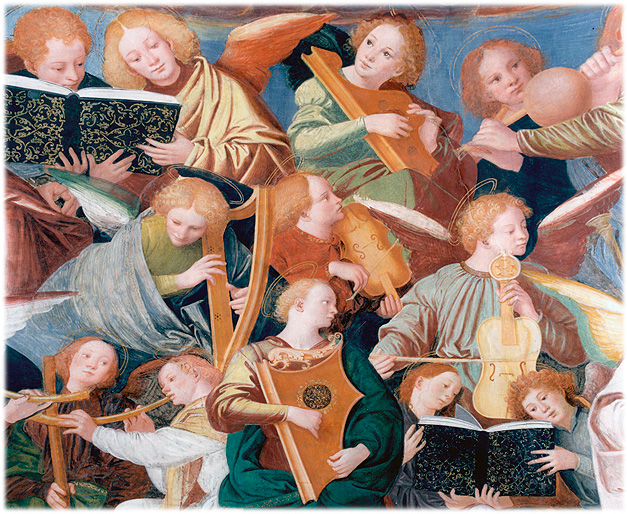
Between the end of the first and the second quarter of the century contemporaneously with Gaudenzio’s presence in Saronno to work on the dome instrumental music enjoyed a golden age. Its apex can be seen in the figure of Francesco da Milano, the “divine Francesco,” one of the century’s leading practitioners of instrumental music for his genius and originality; around him revolved his Lombard students like Pietro Paolo Borrono, Giovanni Maria da Crema, and Pierino Fiorentino. Even if Francesco did not touch the genre of the dance, at the time very popular among lutanists, his production was copious and varied, embracing purely invented music (ricercari and fantasia) as well as music derived from vocal pieces like chansons and motets.
Naturally, the printed music cannot tell the whole story. Where musicological sources are lacking, iconography comes to the rescue with such a variety and intensity of themes as to make us think that music was one of the arts most cultivated also by artists of the brush.
It is no coincidence that, in the great versatility of Leonardo’s genius who offered his services to the court of Milan boasting primarily of his competence in the construction of war machines his ability as a musician was especially appreciated, as witnessed by his sketches of instruments, some pure inventions, such as the organ viol or a flute with slits to obtain (or imagine obtaining) a glissando of sounds. The “Iyre” he built in the shape of a horse’s skull is another facet recounted byVasari. In his Codexes, too, are musical puzzles that attest to his ingeniousness and his interest in music, whose inferiority to painting he felt was due simply to the ephemeral nature of sound which cannot be fixed in time: “Music should be considered nothing other than the sister of Painting, since it is subject to the hearing, the sense second to the eye, and composes harmony with the conjunction of its proportional parts operated in the same time, forced to be born and die in one or more harmonic times, which times surround the proportionality of the parts making up this harmony, no differently than is done by the line of circumference around the members which gives rise to human beauty. But Painting excels and rules over Music because it does not die immediately after its creation, as unlucky Music does.”
We shall see later on, and in particular in the entries on the individual instruments, that Gaudenzio Ferrari invents some objects for producing sound that are not actually historical. Invention of instruments by Leonardo and invention of instruments by Gaudenzio. Is there a connection?
This is a daring statement, but some hypotheses can be posited. Gaudenzio could have known about Leonardo’s experimentation through direct or indirect contact with the drawings and sketches related to his research on the sources of sound; or he could have assimilated, even if only superficially, the fervor of interest in instruments connected with the strong reprisal of instrumental music. Gaudenzio’s propensity to invention would thus not be the result of mere fantasy or of an investigation of form. We can suppose that various stimuli were working together in Gaudenzio when he imagined that an angel could place on his shoulder a hybrid between a flute and a stringed instrument. But certainly it was also his desire to create indescribable, unique, heavenly sounds that moved his fantasy along richly imaginative paths, when it was not the aesthetic embellishment of a scroll or the S-curve of a hard-to-place wind instrument that imposed a play of line and references that became a harmony of its own.
The most attentive scholars of musical iconography have noticed in recent decades that the representation of instruments and the depiction of musical scenes only rarely obey the canons of realism. We have already mentioned certain excursions into the realm of pure fantasy and instances of poetic, or we should say musical, license in Gaudenzio’s work in Saronno. We have also seen that the overall illustration of the “concert” respects on one hand the Platonic idea of the spheres (and we evoked Boethius and Dante), and on the other the devotional intent to be celebrated with the happy chromatic sense of the high Renaissance, which had not yet soured into the acid tints and distortions of post-Michelangelo mannerism. We should add here that even if we could assemble or reunite today an orchestra like the one imagined by Gaudenzio, and have it play a not totally impossible feat in the current fervor to recover instruments and musical praxis from earlier times the musicians would not have enough room, I don’t say to play, but even to tune their instruments. I add: not so much because they would be hindered by their sumptuous dress or because they were perched above our own poor world and subject to vertigo, but because, according to Gaudenzio’s perspective, there would not be sufficient space to draw a bow across the strings, hold a lute, or strike a triangle.
To be sure, angels can do things that humans cannot. But before proceeding to an analytical description of the instruments, a warning of caution is due. A scholar of iconographical problems like Tilman Seebass7 advises us of this. He has observed that even the critical prudence of an illustrious colleague like Reinhold Hammerstein was refuted when he thought he had discovered some dance steps in fifteenth and sixteenth-century cycles of the “dance of death,” a hypothesis contradicted by a dance expert.
“How could this happen?” Seebass wonders, and he goes on to say, “I think the answer lies in the fact that musicians and composers on one hand, and painters on the other, deal with completely different artistic means. Musicians work with sound that vanishes with time [and here we can note a hint at Leonardo’s idea mentioned above], while the painter deals with the visual forms of artistic expression. What happens if an artist paints music, if he visualizes sound? There is no clear and simple answer. What is certain is only that music is not his professional activity. In all likelihood he is not an expert on music; he has probably never built an instrument, and it is unlikely that he has ever composed a piece of music. His professional merit is not that of rendering music in a performance, but of visualizing its substance, affects, and function... What we want, but do not often find, is a correct rendering of the construction of the instrument, its color, material, the way it is held, tuned, and played, as well as the right number of players.”
Even though sometimes the depictions are so precise and accurate as to make it possible to reconstruct the instrument, or to read in its trademark the name of the ancient luthier, more often “Let’s face reality... the perspective is wrong, the number of strings and holes is impossible, and the bridge is in a completely absurd position from the acoustical standpoint... A deeper reason for such a lack of realism lies however in the fact that musical instruments often have a symbolic meaning... they can be bearers of religious, moral or social messages, or they can become an image of beauty, that is, take on an aesthetic value.” Seebass’s words are indisputable and keenly perceptive, convincing us more and more of Gaudenzio’s limited knowledge of the construction and playing of instruments and of musical problems in general.
As opposed to Leonardo, who knew about music and instruments, Gaudenzio Ferrari loved music but did not practice it. And his “concert” is certainly a concert made up of grace and color, of movement and stylistic balancing acts, of suggestions of music: a concert to be enjoyed with eyes wide open.